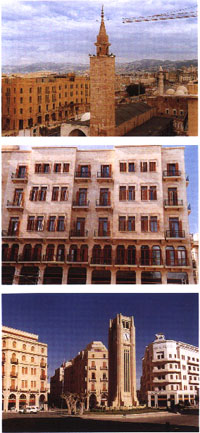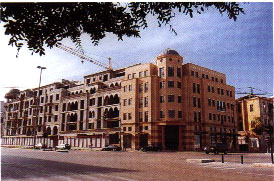
|
October - December 1 9 9 9 |

|
The
conservation area The city center is gaining life as more quality space, delivered through restoration and new construction, attracts returnee or relocating activities. Restoration is bringing back the historic Beirut Municipality building to its former glory. The building was designed in 1923 by Youssef Aftimos, architect of a number of important buildings and monuments, including the Grand Serail clock tower. The four monumental facades, now restored, underline the Municipality as a major urban address, facing Al Omari mosque and forming a grand entrance to the Foch-Allenby area. Internal refurbishment is expected to take another six months. A sophisticated design, inspired by architectural heritage, the original Municipality also responded to functional considerations and adopted modern techniques relating to office buildings. Shops with their ancillary basements occupied the ground floor. Facing the Municipality on Weygand street, Emir Assaf mosque has been beautifully restored. Al Omari mosque is regularly welcoming the faithful, as its interior is operational. The minaret has been repaired, with works to follow on the dome, the entrance and the Maarad street facade. Along with the |
|
| restoration of
other places of worship in the city center, final blueprints have
been submitted for reconstruction of Mohammad Al-Amin mosque, near
the Maronite St George cathedral, on Emir Bechir street off Riad El
Solh square. On the corner of Weygand and Maarad streets, the Atrium commercial development constitutes a harmonious infill with the Maarad arcades, while heralding the new developments around the Souks of Beirut. The building facades are nearing completion, with project delivery expected in the year 2000. Decoration works prepare for the opening of the Cercle Hitti gallery on street level. Inaugurating the new Al Hayat newspaper and Al Wassat magazine premises in Maarad street on November 26, Prince Khalid Bin Sultan Bin Abdul Aziz Al Saud declared: " We are bringing back Al Hayat to its original homeland." The Italian Embassy is moving to the Assicurazione Generali Building in Nejmeh Square. Middle East Airlines and Misr Airlines are returning to the city center, where Tunis Air is already opening. New tenants include Ericson on Riad El Solh square and Rim Natural Water in Riad El-Solh street. |
||
| The residential neighborhoods | ||
|
More residential
and hotel projects are soon to start in Saifi, Zokak El Blatt, Wadi
Abou Jamil and Minet Hosn. The financial district The city center
is a focus of financial activity, with quality establishments ranging
from banks to insurance companies and other financial institutions. |
|
|
|
In
the city center With summer
lingering on and leading to Indian summer, Beirut city center was
home this quarter to a number of outdoor activities. The Grand
Theater, still
unrestored, is associated in the memory of Beirutis with the
artistic and cultural tradition of their city center. In this
heritage building of the late 1920s, the Nadia Tueni Foundation and
the French Cultural Mission organized, on November 5 to 7,
successful performances of 'Chagrin d'Amour', an early play by
the Lebanese poet and playwright Georges Chehade.
|






